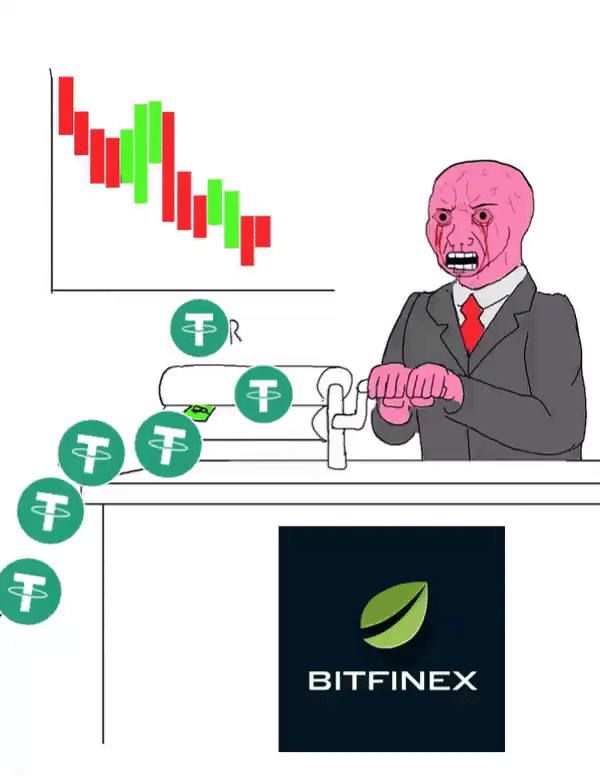Elon Musk got Tesla into Bitcoin on 8 February, and my phone’s been melting since. Here are some Frequently Asked Questions:
- Is this a bubble? Yes it’s the bubbliest bubble that ever did froth.
- Wot about Tesla’s green credentials? Musk was always a huckster, don’t be dense.
- Don’t you wish you’d bought in?? No.
- never asked: Does printing tethers at a billion a day have anything to do with this? One or two things.
The Bitcoin price rocketed up on Musk’s announcement! This wasn’t driven by retail — it was the large holders pumping the price on the margin trading exchanges. You’d almost think they’d timed it. [CoinTelegraph]
But the retail traders are finally showing up, after all the pumpers’ hard work with tethers over the past couple of months!
And the normal everyday no-coiners are noticing Bitcoin’s power consumption — and the CO2 production.
Tether printer go brrrrr
The price of Bitcoin is being pumped higher and higher, assisted — as it was in the 2017 bubble — by judiciously-applied tether issuance. Or, as it’s turned into, spraying the tether-based exchanges that make up Tether’s very few customers with as many tethers as they need to keep the number up.
Retail suckers are finally diving into the shark tank, eager to be the chum. Nick Evans, a journalist friend in Melbourne, overheard a couple of blokes down the pub, talking about investment properties versus putting their money into Ethereum. He resisted the urge to bludgeon them to death with a copy of Attack. [Twitter]
(Remember: swing the book spine first, and you can take off their head in one clean swipe. At which point, two heads spring up from the stump. Both still talking about their holding.)
Tether has given up caring about plausible appearances, and is now printing a billion tethers at a time. As I write this, Tether states its reserve as $34,427,896,266.91 of book value. That’s $34.4 billion — every single dollar of which is backed by … pinky-swears, maybe? Tether still won’t reveal what they’re claiming to constitute backing reserves.
JPMorgan has issued a report, “Digital transformation and the rise of fintech: Blockchain, Bitcoin and digital finance 2021,” on the state of the crypto market. Tether is all through it as a risk factor:
Were any issues to arise that could affect the willingness or ability of both domestic and foreign investors to use USDT, the most likely result would be a severe liquidity shock to the broader cryptocurrency market which could be amplified by its disproportionate impact on HFT-style market makers which dominate the flow.
You should Ctrl-F for “tether” in this document — the analysts have done their best to document the known problems. [Bloomberg; report, PDF]
Ben Power of the Australian Strategic Policy Institute has also outlined the security risks of Bitcoin — including Tether. [ASPI]
Tether’s mid-February delivery deadline for documents requested in discovery has passed, and now the New York Attorney General gets to work on how it’s going to proceed. I don’t expect visible action on Tether immediately, but Document Delivery Day definitely starts the next act.
I am told that many people in the NYAG’s office are really quite keen to nail Tether to the wall, nether regions first. They’re busy with doing the same to Donald Trump, but the NYAG has enough staff to walk, chew gum and nail nethers.
(I’m told this by someone who I’m pretty confident has close knowledge of the NYAG’s thinking on the matter. So be of good cheer! If even more patience than we’ve had to have so far.)
Nicola Borzi is an Italian finance journalist. He’s written a nice article on Giancarlo Devasini of Tether and Bitfinex for Il Fatto Quotidiano. He’s also translated it into English for you. [Il Fatto Quotidiano, paywalled; Medium]
NYAG has shown some opinions on shonky crypto firms. NYAG charged Coinseed with an unregistered offering of securities in their ICO, and running a Bitcoin exchange dealing with New York customers without an appropriate license. The AG’s press release says: “Unregulated and fraudulent virtual currency entities, no matter how big or small, will no longer be tolerated in New York.” So let’s see what happens. [Press release; complaint, PDF]
Photo by Hans at Pixabay, CC-0
Burn it all down
Now that Musk has brought Bitcoin to public attention, the normal people are talking about Bitcoin’s crime-against-humanity CO2 production. And the coiner excuses aren’t working on the normal people, who understood that Bitcoin was scammy fake money for nerds — but didn’t realise about the CO2.
I spoke to a few BBC News departments on the subject, and the story they all wanted was Elon Musk and Bitcoin’s now-Argentina-sized CO2 production. Particularly the bit where Tesla got clean energy credits, sold them for $1.5 billion, then spent $1.5 billion from the same pool of money on bitcoins — wiping out all of that good work, and the specific purpose the clean energy credits existed for. [BBC News]
Other mainstream press is taking the same tack — it’s turning out you can’t talk about Bitcoin without mentioning the CO2. The Times: Bitcoin is helping to destroy the environment. [Times, paywalled]
Martin Walker asks: can investors embrace both cryptocurrencies and ESG? Bitcoin obviously fails “environmental” hard — but it also fails “social” and “governance.” [LSE Business Review]
But Bitcoin is the true freedom coin for all of humanity! Except Uyghurs, who get to work in the Bitcoin mining plants in Xinjiang whether they want to or not. Can’t wait to see the Human Rights Foundation speaking up about that one. (I’m pleased to say that many crypto-loving libertarians I know are really pissed off about this.) [Bloomberg]
Ethereum advocates have been talking up how Ethereum is totally going proof-of-stake any time now, definitely, you betcha — though they’ve been saying that since 2014. But at present, and for the foreseeable future, Ethereum is no more ethical on CO2 production than Bitcoin — it’s smaller, but still approximately a Lebanon or Iceland (without the geothermal). [Digiconomist]
Ethereum and a lot of altcoins are still mined on graphics cards. That’s good news for NVidia, right? Well, no — in NVidia’s Q2 2018 earnings report, they’d anticipated $100 million from video card sales for cryptocurrency mining, and grossed $18m. [Seeking Alpha, 2018] So to keep from alienating their solid core audience of gamers, NVidia’s GeForce driver software will now detect and penalise mining algorithms being run on the cards! You can buy one of NVidia’s crypto-mining cards instead. [The Register]
Stephen Diehl on Bitcoin mining: The Crypto Chernobyl. [blog post]
I was going to update my 2018 article on bitcoiners’ bad excuses for proof-of-work — but Amy Castor has instead. [Amy Castor]
What happens next?
Bubbles grow until they pop. Timing the pop, that’s the tricky bit.
Tether will keep pumping out fake dollars until they’re stopped. This could be tomorrow, or in months. The question is how long the peg can hold — how long traders believe these things are dollars.
“Institutions” are not in fact getting into Bitcoin, because it’s too damn volatile. [news.bitcoin.com] Companies buy Bitcoin when a bitcoiner in upper management gets the company card, spends company cash on bitcoins, and issues a press release. Grayscale is not in fact taking in dollars from institutions, it’s taking in bitcoins from DCG’s hodler mates.
So the good news is that Bitcoin has failed to become systemic … yet. If crypto self-immolates, neither the stonks market nor what’s left of the real economy will care.
Regulators will very slowly get themselves together — while retail investors get burnt.
You said what? https://t.co/6Y0vGSX5nA pic.twitter.com/mmUGCSkmwm
— HODL (@HodlStyle) February 21, 2021
Your subscriptions keep this site going. Sign up today!


